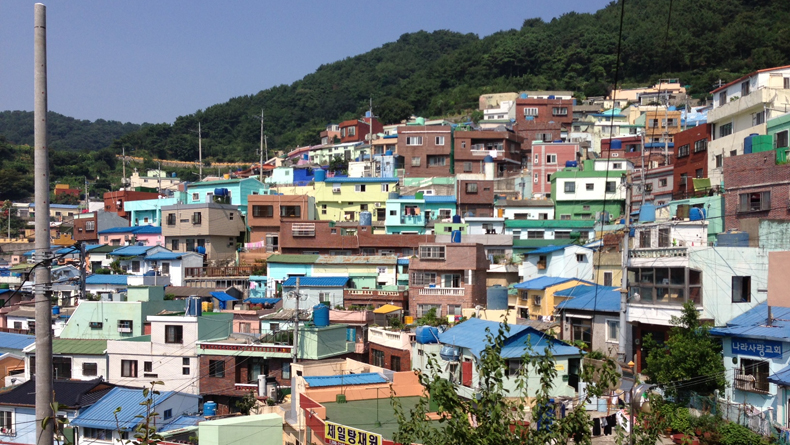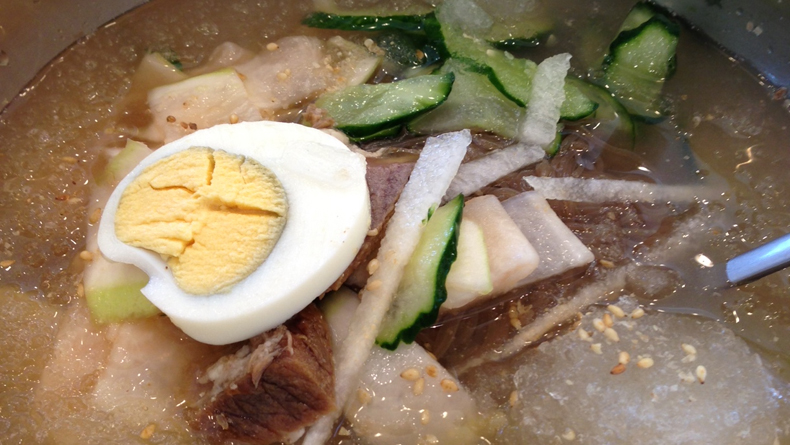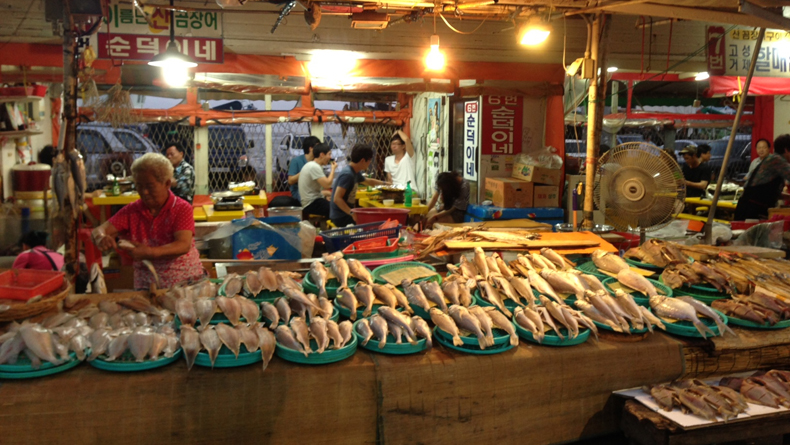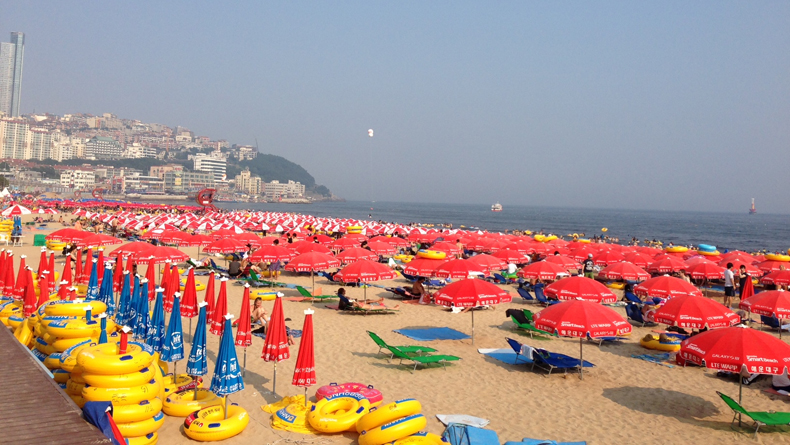The Kitsch and Quirk of Busan
It was the second week of August when South Korea announced its worst energy crisis. Two power plants stopped operating and government buildings were asked to turn off their air conditioning. Even shopping malls would be fined if the temperatures were set to lower than 26 degrees Celsius. A heat wave was making its way through northern Asia when we found ourselves melting in Busan, South Korea’s second largest city.
I had been to Seoul many times before, especially when living in Tokyo. Seoul is only a two-hour flight from Tokyo and because my husband is Korean-Canadian, it was always nice to re-familiarize myself with the culture I married into. To me, this was also known as visiting the mother(in-law)land. The idea of visiting Busan came up on a whim. We had never been there before, but we were hoping that it would be a seaside version of Seoul, one of my favorite cities for shopping and eating.
Due to an awkward flight schedule, we arrived at our hotel at approximately 4 a.m. and were politely refused check-in. We killed a few hours by going to the only place we knew that would take us at that hour of the day: a jjimjilbang, or public bathhouse. These are similar to Japanese bathhouses in that there are gender-specific areas to bathe in communal hot tubs, but what’s different is the a co-ed lounge area where you are free to sleep. For a total fee of 20,000 South Korean won (about ¥1,800), my husband and I had access to the sauna, hot tub and lounge area (not to mention our nifty pajama-like outfits).
The lounge area is basically a huge room where you sleep on the floor. There are smaller rooms on the periphery: some with charcoal walls, some with higher levels of oxygen and some for women only. We grabbed a thin mattress and foam block pillow from the pile and recovered from the red-eye flight in the main room while we waited for our hotel room to be ready. At 5 a.m., the jjimjilbang was filled with middle-aged salarymen and university students, mainly male. No matter where you are in Korea, a visit to the jjimjilbang is a must. Where else can you pay to change into pajamas and sleep in a communal room on the floor?
On the first day of our four-day visit we decided to explore the area of Nampo-Dong. This is one of the main shopping areas. Most taxi drivers will recommend this area if you express your desire to shop.
I should note at this time that if you’ve been to Seoul and are familiar with the language barrier, you’ll find it’s even greater in Busan. While the metro system is convenient and affordable, if you’re traveling with a party of two or more it might just be easier to take a taxi. Just bring a map and a smile. Like Seoul, in the tourist areas (like Nampo) you’ll be solicited in broken Japanese, and some restaurants will have menus in English, Chinese and Japanese.
Nampo reminded me of a mix between Shibuya and the back streets of Omotesando. The shops were trendy and contemporary, but the streets were wide enough and set up for a leisurely stroll on a sunny day. We wandered into a naengmeong (buckwheat noodles) restaurant for our first meal. We decided to go with hwe naengmeong (noodles with spicy fermented skate) and mul naengmyeon (noodles in a cold broth with ice) since Busan was known for its seafood and because an ice soup was very appealing in what felt like 41-degree Celsius weather.
While wandering through Nampo-Dong we unintentionally walked through a few other things: BIFF Square and the Jagalchi Market. BIFF stands for the Busan International Film Festival, which is scheduled to take place this year from October 3 to 12. Originally Busan’s movie district, the area was renovated and converted into a cultural tourist area in 1996 and hailed as BIFF Square. This is one of the venues for the film festival, and there you’ll find cemented handprints of famous Asian and international actors and filmmakers, unfortunately none that I recognized.
The Jagalchi Market was a little more interesting. We wandered in by accident right around the time the sun was setting. This provided lovely mood lighting for all the wonderful and strange fish we saw people eating. Women wearing a lot rubber (gloves, aprons and shoes), know as Jagalchi ajumas (ajuma meaning a middle-aged or married woman) tried to charm us as we passed by their stalls. They invited us to eat these weird things they were skinning (eels) and scaling in front of us. I don’t know if you’ve ever witnessed live eel being skinned and chopped up, but I do not regret not eating at the Jagalchi Fish Market. Having seen some pretty unique aquatic creatures in Tsukiji Market and Sai Kung in Hong Kong, I can say that some of the most unappetizing animals I have seen were in Busan. I did admire those who could stomach it and who seemed to be enjoying the variety of fresh seafood available. But whether you choose to consume or not, Jagalchi Fish Market was one of the most eye-opening things I saw in Busan.
If there was one just thing I wanted to do in Busan, it was to visit the Gamcheon Culture Village, so the next morning we made it a priority to go there. The fact that it’s even called a cultural village should hint to its campiness and kitsch. Originally the slums of Busan and home to some of the poorest residents, the government decided to turn this hill of shacks and tiny houses into “Busan’s Machu Picchu.” The result is a colorful, scenic neighborhood filled with murals, unexpected sculptures and the most adorable old people (residents) walking around picking up garbage to keep their neighborhood clean. Was the idea and execution contrived? Very much so, but if it improves the lives of low-income families and provides me with interesting photos, then I’m happy to support this project even if it is oddly referred to as the Machu Picchu of Busan.
And finally, we could not write about Busan without mentioning the most famous beach in Korea: Haeundae Beach. My husband and I had already Googled photos of this beach before visiting and we decided that lying there or trying to would be the wrong decision. The facts: Haeundae has the world’s record for most parasol umbrellas on a beach. In August of 2011, 7,937 parasols were counted along the 1.5-kilometer beach. The beach has 200 lifeguards, its own police station, and during peak season (late July to early August) it’s estimated that up to one million people visit Haeundae Beach each day. The umbrellas completely covered the sand. We wondered how often people got lost trying to find their spot again, or if they even enjoy themselves while sharing the sand with 999,999 other beach-goers.
There are alternatives though. If you’d like to avoid parasol beach, or are looking for something more relaxed, I would recommend Gwangalli Beach. At night local singers set up to serenade you along the boardwalk, and there are a variety of beach-facing pubs and coffee shops that look out onto the lights of the Gwangan Bridge. Within our four days there we also managed to visit to the Busan Museum of Modern Art and the stunning Haedong Yonggungsa Temple. We also accomplished our mission of finding and eating bajirak kalguksu, handmade soft and chewy noodles with clams, a Busan specialty.
If Seoul is like Tokyo, then Busan would be Osaka. I emailed my mother-in-law (originally from Seoul) a few photos of Gamcheon Culture Village and Jagalchi Fish Market. I didn’t realize I was reinforcing her image of a rough, uncultured, emotional town. She wrote back, “Your stomachs must hurt from eating in the fish market and all the other food there. Be careful and watch out for your belongings.” My husband sent her a few other photos of Trump Towers by Haeundae Beach just to show her that Busan had evolved since that image she had of this seaside city in the 60s.
If you enjoy Korean food and culture and are looking for a quirky, kitschy place to visit, then Busan is where you get the familiar tastes of Seoul, but the edge and campiness of Osaka.
The Deets
Getting There: Korean Air and Japan Airlines fly directly to Busan from Tokyo.
Where to Stay: We thought we made the mistake of staying in the city (around a 20-minute taxi ride from most things), but in hindsight it turned out to be a good break from the crowds. If we were to visit Busan again, we would recommend areas and hotels like the The Westin in a quieter area of Haeunae, or even a local hotel in Nampo-Dong or Gwangalli Beach.
More Information: For additional details, visit Dynamic Busan.













Leave a Reply